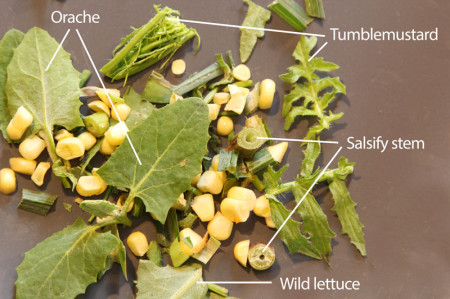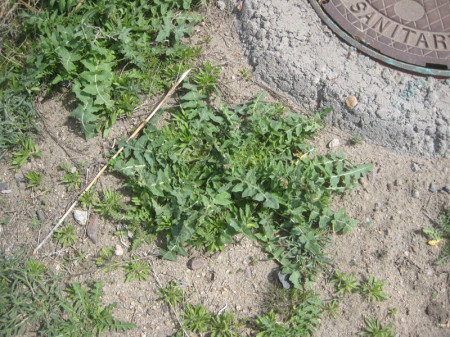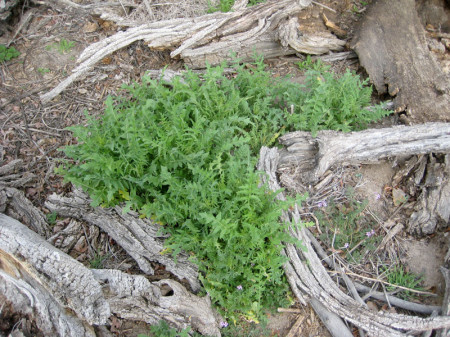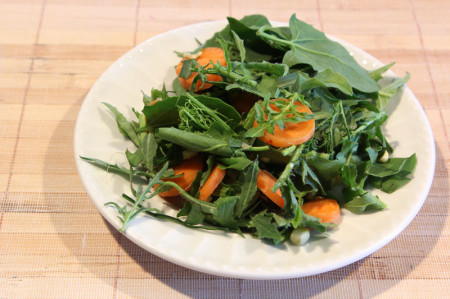
Just when I think I know everything there is to know about wild mustards, I find another one to eat. This time, I am excited about tumblemustard (Sisymbrium altissimum), which you might know better as tumbleweed, because at maturity when it dries out it detaches from its stem and tumbles on the wind, spreading its seed about.
There are numerous species of plants that do this and are referred to collectively as tumbleweeds, so don’t go eating any old tumbleweed just because I said I like it in salad. Tumblemustard is a Mustard family member, related to broccoli, cauliflower, kale, and other mustards. It starts from a spirally basal rosette of long, many-lobed leaves that are quite different in appearance from the frilly, smaller leaves that appear higher up when the plant bolts. Like other mustards the (generally lemon yellow) flowers are four-petaled.

“Tumblemustard at first does not seem to display the obvious squirrel-tail racemes seen in other mustards,” writes local wild plants professor Cattail Bob Seebeck in his 2012 Survival Plants textbook. “Look for them. They’re there. The linear branch tips are actually seedpods.”
This explains why, several years ago after I moved to Colorado and happily collected a “tumbleweed”—which was then, for me, a curiosity—and brought it back to the Fairplay house at 11,000 feet, a tumblemustard later sprouted. It’s because the thin “branches” held hundreds of seeds within their lengths.
Anyway, it’s crazy it took me so many years to give tumblemustard a try. But after recent success with other mustards—specifically the unopened bud clusters of hoary cress (Cardaria spp.) and the pre-flowering shoots of musk or blue mustard (Chorispora tenella)—the other day down in Aurora I finally gathered some young, lighter green tumblemustard leaves, both the young, unfurling frilly ones and young, divided, basal rosette leaves—to test in the kitchen.

These came from a somewhat dry field around 6,000 feet. Nearby, a few prairie dogs yelled at me, and in the distance there was a small creek lined with cottonwoods, to give you a sense of the habitat. On my walk that day I’d seen many young tumblemustards, but not all seemed fit for food forage. Some were too close to trodden paths, or to metal detritus of a previous era that had me questioning what the land had been used for prior, or to the prairie dog mounds. But when I found some lush specimens I liked, I gathered a few handfuls of young basal leaves, and clipped the top bundles of frilly leaves that were just starting to bolt.
Back at the house I gave them a good washing and chopped them into bite-sized pieces, then popped a young basal leaf bit into my mouth. The mustard flavor was there, but relatively mild compared to pennycress, and the midribs had a nice crunch and surprising juiciness. Not bad. I gave Gregg a taste and his assessment was similar. Salad time!

Never Get Tired of Wild Salads
For last night’s salad I mixed young prickly lettuce greens, tumblemustard greens, and orache (Atriplex heterosperma), a triangular-leaved spinach relative that has a hint of salt to it, along with the chopped stems and leaves of a young salsify plant (Trapogon sp.). I think this might be my first salad with 100% wild greens. I found it a little dense due to the orache, but the mustard lightened things up a bit. To the wild green mix I added carrots and sweet corn cut from the cob for texture, with avocado and a nice oil and Balsamic vinegar dressing served on the side.
“I love your wild salads,” Gregg said after polishing off my tumbleweed creation. “They make me feel so healthy.”
Updated 2.22.21

I adore the labeled salad picture. What a great idea!
Thanks to your delightful articles and facebook posts, I now stroll through my property going- “Yep. I can eat that. Oooh, must try that one. Oh look! Salsify too.” lol Just when I think I’ve identified every edible around me, something new pops up. Keep up the great work, and the inspiring recipes!
Thank you so much for that kind compliment!